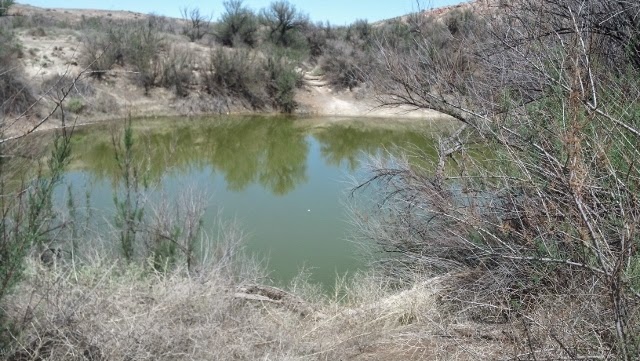An aerial view and, no, I didn't take this picture.
Lazy Lagoon is at the left and Lea Lake is on the right.
We stopped at the visitor center wanting to purchase an annual entrance pass. The park ranger, David, waived the daily fee when we told him we were volunteers at BLNWR.
 |
| Cottonwood Lake |
The first cenote, Cottonwood Lake, is a short walk behind the VC.
Although the lakes are from 18 to 90 feet deep, the color caused by algae, make the depth seem greater.
 |
| Cottonwood Lake |
Mirror Lake - aptly named
We skipped Inkwell Lake this trip due to several fishermen on the edge.
Invasive Salt Cedar has taken a toll on the landscape.
The second largest is Lea Lake, and the only one where swimming is permitted.
 |
| The view from the top of the escarpment |
We birded picking up a total of only 15 species, mostly White-crowned Sparrow. Best birds were Spotted Towhee and Rock Wren. A Rock Pigeon with cooing echoing from off the canyon wall at Cottonwood Lake presented a mystery until we were able to pick him out from the rocky terrain.
Lazy Lagoon was dotted with coots and an assortment of ducks, Ruddy, Redhead, Shoveler, Gadwall, and Mallard. One lone Canvasback was present on Mirror Lake.
Butterflies were abundant, mostly Checkered White, with Saltbush Sootywing, and Marine Blue positively ID'd.
The ninth lake, Dimmitt Lake, just south of the park boundary is owned by the Fin and Feather Club established in 1911.
The ninth lake, Dimmitt Lake, just south of the park boundary is owned by the Fin and Feather Club established in 1911.
We will visit again during our tenure in Chaves County.






.jpg)
.jpg)
.jpg)
.jpg)
.jpg)
.jpg)
.jpg)
.jpg)
.jpg)
.jpg)
.jpg)
.jpg)
.jpg)
.jpg)
.jpg)
.jpg)
.jpg)
.jpg)
.jpg)
.jpg)
.jpg)
.jpg)
.jpg)
.jpg)
.jpg)
.jpg)


.jpg)
.jpg)
.jpg)
.jpg)
.jpg)
.jpg)
.jpg)
.jpg)
.jpg)
.jpg)
.jpg)
.jpg)
.jpg)
.jpg)
.jpg)
.jpg)
.jpg)